In this Sunday, Oct. 18, 2015, photo, a girl writes on a chalkboard outside the Art on Sedgwick storefront studio in Chicago. The chalkboard was installed to get people interacting on a street where few people stop to chat. (AP Photo/Martha Irvine)
The Associated Press
CHICAGO (AP) - Charlie Branda is not an artist. When she opened an art studio on a stretch of asphalt known as Sedgwick Street, the 53-year-old mom and former commercial banker simply wanted to get to know her neighbors and to connect two sides of a thoroughfare that divides black and white, haves and have-nots. "The way it is now isn't the way it has to be," she remembers thinking.
Branda had lived for years in and around Chicago's Old Town neighborhood when she, her husband and two children moved into a red-brick house on the east, and wealthier, side of Sedgwick in 2008.
Initially, she joined with her neighbors to demand that the city, police and absentee landlords do something about drug-dealing and occasional gunfire in the neighborhood. But she also spent a lot of time walking around, ignoring those who advised her to stay on "her side" of the street.
"Hello!" she'd chirp, smiling as she greeted strangers from Marshall Field Garden Apartments, a subsidized complex on the west side of Sedgwick.
Then in 2013, a young African-American father was fatally shot while on his way to buy diapers, just steps from the Brandas' home. Some residents were ready to move, and at least one family eventually did. But Branda couldn't shake the idea that she didn't even know the family that had lost a loved one.
"She saw us as neighbors," says Adell Thomas, a longtime resident of Marshall Field and president of its tenants' association.
Branda had been reading a book - "Make the Impossible Possible" by William Strickland Jr., a community activist in Pittsburgh who credits a high school art teacher with helping him find his way in life. She kept thinking about an image Strickland described: a ball of clay and how "you can make a miracle with your hands," she recalls.
She began telling people about her vision for a neighborhood art studio, and eventually presented the idea at community meetings. Thomas was inspired and quickly decided: "I want to be part of that." As she got to know Branda, Thomas was surprised to learn she'd grown up in Anchorage, Alaska, with a single mom and modest means. Branda, meanwhile, saw a bit of her tough yet compassionate mom in Thomas.
A board was formed, and in October 2015, the first Art on Sedgwick studio opened in a tiny storefront across the street from Marshall Field Garden Apartments. That day, neighbors stopped to write on a large chalkboard outside the studio that had rows of the unfinished sentence, "Before I die, I want to ______."
"Do Art," one girl wrote. And so it began.
The first classes, including cartoon drawing and embroidery, were small but consistently attended. The victories also were small but satisfying. It started with "just showing up," says Cory Stutts, middle school director at the private Catherine Cook School, two blocks east of Sedgwick Street.
Last year, an effort known informally as "the kite project" brought together sixth-graders from Catherine Cook and Manierre Elementary, a public school tucked behind the Marshall Field apartments. The kids were paired off and instructed to interview one another, asking questions like: "What do you dream about?" ''Do you think about dying?" ''Are you scared?" Then came a portrait session; the photos then were made into kites.
"A group of white kids and black kids playing together - you really don't see that nowadays," marveled Manierre student Eric Evans.
With each art show, class and community event, more people have trickled into Art on Sedgwick. One Saturday each month, a faithful group of adults from varied backgrounds gathers at the studio for a "Sip and Paint," a chance to do art, chat and drink a little wine. Branda and Thomas, now friends, often take part.
"In some ways, I feel like we've accomplished so much in terms of building community and maybe changing the discussion," Branda says. "On the other hand, I feel like we've just barely scratched the surface."
There are people on both sides of Sedgwick who aren't so sure the neighborhood's divides can be bridged. Even as property values on his side of the street have increased, Branda's next-door neighbor, Jerry Capell, says the disconnect is "as wide as it's ever been," and that saddens him.
From her apartment on the other side of the street, Eric Evans' mother, Sherise McDaniel, also still sees very separate worlds.
"I would consider Charlie the exception. Charlie is like a vein connecting those people to us and us to them," says McDaniel, who is African-American and a special education aide at a high school. "I love this neighborhood. ... I love this city. I wish it loved me back."
Branda still walks the neighborhood and greets residents, many of whom know her now. "You can't 'un-connect' us," she insists.
She gets teary when she says this. "I think I'm tired of the divisiveness," she explains.
A while later, outside the Art on Sedgwick studio, a few kids from Marshall Field run to hug her, as they often do.
"Hi, art teacher! Hi, art teacher!" they shout. Branda wraps her arms around all of them, closing her eyes as she squeezes tightly.
She still doesn't consider herself an art teacher.
But she is their neighbor.
____
Art on Sedgwick: http://www.artonsedgwick.org/
____
Martha Irvine, an AP national writer and visual journalist, can be reached at mirvine@ap.org or at http://twitter.com/irvineap
In this Thursday, July 5, 2018, photo, teen artists concentrate on a model as they draw during a summer class at Art on Sedgwick in Chicago. The drawing class was part of the After School Matters program, which provides cultural activities for Chicago teens. It is one of several classes at the studio that brings together people from diverse backgrounds who may not necessarily get to know one another. (AP Photo/Martha Irvine)
The Associated Press
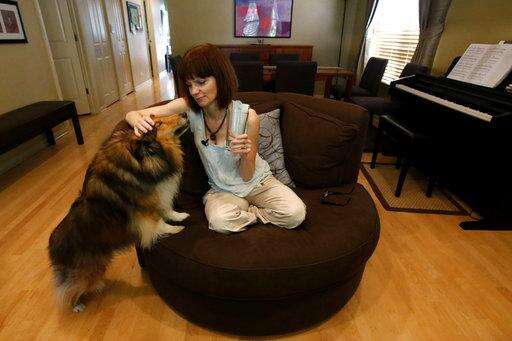
In this Tuesday, June 23, 2015, photo, Charlie Branda, founder of Art on Sedgwick, pets her dog at her home in Chicago. Branda, now 53, moved to this home in 2008 and immediately felt that the nearby Sedgwick Street divided the neighborhood along racial and economic lines. She set out to try to unite people after a shooting near her home in 2013. While at least one of her neighbors moved away because of crime in the neighborhood, Branda opened an art studio four months after this photo was taken. "I wanted to get closer to people who were my neighbors," she says. (AP Photo/Martha Irvine)
The Associated Press
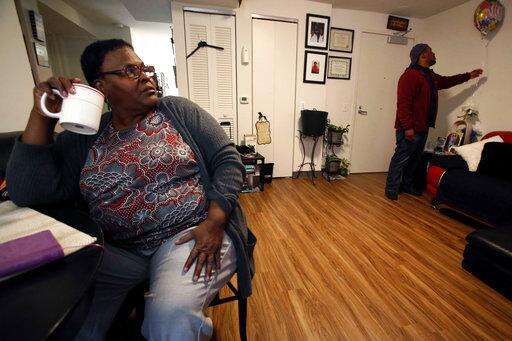
In this Tuesday, May 22, 2018, photo, Adell Thomas sits in her Chicago apartment as her son, Jamarius Esper, readjusts the balloon he got her for Mother's Day. Thomas, now 62, has lived in the subsidized Marshall Field Garden Apartments for several years. She said she kept to herself for many years and viewed her white neighbors across the street as, "They're not for us, so we have to be for ourselves." She has since decided to branch out and has gotten involved with a neighborhood art studio known as Art on Sedgwick. "I don't want to look at people in a different way," she now says. "I want to look at people as we're one big happy family." (AP Photo/Martha Irvine)
The Associated Press
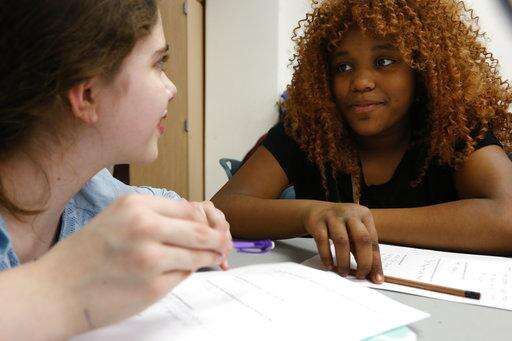
In this Thursday, April 27, 2017, photo, Miracle Shanklin, right, and Isabella Iniguez, both age 12 when this photo was taken, talk during an ice-breaker exercise in Chicago. The session brought together students from the public Manierre Elementary School and the private Catherine Cook School - on opposite sides of Sedgwick Street. The students said they found the conversations awkward at first, though they eventually loosened up. They talked about everything from family, school and hobbies to their views on safety in the neighborhood. (AP Photo/Martha Irvine)
The Associated Press
In this Friday, May 5, 2017, photo, two girls play hand-clapping games in Chicago. The students from the public Manierre Elementary School and the private Catherine Cook School came together for an art project organized by Art on Sedgwick, a neighborhood art project that aims to unite people from diverse backgrounds. (AP Photo/Martha Irvine)
The Associated Press
In this Saturday, Feb. 10, 2018, photo, Adell Thomas, left, cracks a joke during a "Sip and Paint" class for adults at Art on Sedgwick, in Chicago. The class brings people from different backgrounds together to socialize. Art on Sedgwick was founded by Charlie Branda, center in glasses, as a way to unify a neighborhood that is divided by income and race. The core group of regulars is one of the studio's successes. "But we're nowhere near where I want us to be," says Thomas, who has become a board member at Art on Sedgwick.
The Associated Press
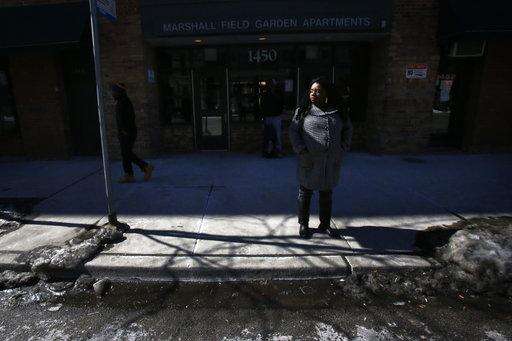
In this Tuesday, March 5, 2015, photo, Precious Murphy stands outside Marshall Field Garden Apartments, one of the last larger-scale buildings with subsidized housing in a neighborhood that was once home to the Cabrini-Green housing project in Chicago. Despite her interest in Art on Sedgwick and friendship with its founder, Charlie Branda, Murphy and her four children moved to Bloomington, Indiana, to start a new life. Murphy said she couldn't wait to move from a set of buildings that are often the target of resentment in a gentrifying neighborhood. That said, she regularly returns to visit Branda and is "very proud" of the work happening at the art studio. (AP Photo/Martha Irvine)
The Associated Press
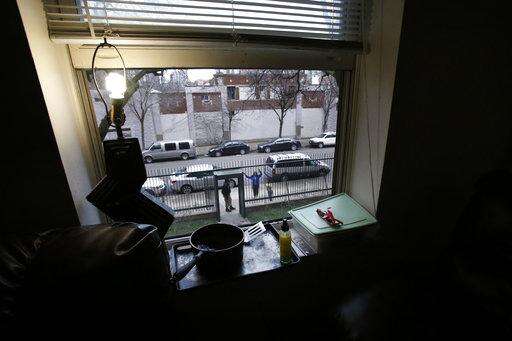
In this Friday, April 13, 2015, photo, taken from the Chicago apartment of Precious Murphy, one of Murphy's daughters raises her hands in glee as a usually locked gate to the building is opened while they move their belongings. The family moved to Bloomington, Indiana, in search of a better life. This unit and the rest of the subsidized Marshall Field Garden Apartments were renovated after Murphy left but remain subsidized in a neighborhood where affordable housing is increasingly scarce. (AP Photo/Martha Irvine)
The Associated Press
FILE- In this Wednesday, Nov. 8, 1995, file photo, a wrecking ball tears away at one of several Cabrini-Green public housing project buildings in Chicago. Since the last of those buildings was torn down in 2011, real estate prices in the neighborhood have skyrocketed as the neighborhood has quickly gentrified. (AP Photo/Beth A. Keiser, File)
The Associated Press
FILE-In this Wednesday, March 30, 2011, file photo, graffiti reading "I Need Money" is visible in a partially demolished high-rise at the Cabrini-Green public housing project in Chicago. This building was the last of these high-rises to be torn down in a demolition process that began in 1995. Some residents of Cabrini-Green stayed in the neighborhood _ at places like Marshall Field Garden Apartments on nearby Sedgwick Street. However, subsidized housing is becoming scarce in a neighborhood now filled with luxury homes and condos. (AP Photo/M. Spencer Green, File)
The Associated Press
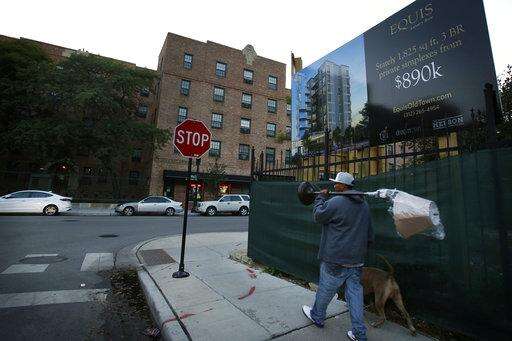
In this Thursday, Aug. 24, 2017, photo, a man carrying a lamp walks past an advertisement board for new apartments in Chicago's Old Town neighborhood. Marshall Field Garden Apartments, subsidized housing, in background, sits on the west side of Sedgwick Street. Expensive homes and condos are continuing to rise up on the east side of the street, with one such building planned for this corner. (AP Photo/Martha Irvine)
The Associated Press
In this Tuesday, March 5, 2015, photo, a dead rat sits on the street outside Marshall Field Garden Apartments in Chicago. Before Marshall Field Garden Apartments was renovated, tenants frequently complained about rodents. Residents say life has improved since the renovation _ and they were surprised that the building remained subsidized in a neighborhood where affordable housing is scarce. (AP Photo/Martha Irvine)
The Associated Press
In this Sunday, Oct. 18, 2015, photo, a young man walks past Marshall Field Garden Apartments in Chicago. Marshall Field Garden Apartments was purchased and renovated, beginning that same year. Although some community members hoped the complex would be converted to high-rent housing, the owners, Related Midwest, decided to keep it affordable. (AP Photo/Martha Irvine)
The Associated Press
In this Thursday, July 5, 2018, photo, Harris Capell, second from left, and his girlfriend, Adilene Barragan, talk, while his dads, Kevin O'Brien, second from right, and Jerry Capell, right, listen from the kitchen of their Chicago home. The two dads bought a home on the east side of Sedgwick Street two decades ago and adopted Harris, now 18, and younger sister Maya, not pictured, in the years following. Jerry Capell says the divide along Sedgwick Street is wider than ever and largely driven by economics. (AP Photo/Martha Irvine)
The Associated Press
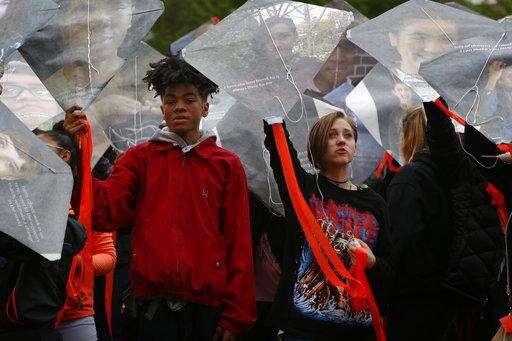
In this Friday, May 19, 2017, photo, Justin Nwoye and Heidi Wier, both eighth-graders when this photo was taken at Franklin Fine Arts Center near Chicago's Sedgwick Street, hold kites. The "kite project," as it was informally known was a public art event orchestrated by Art on Sedgwick and resident artist Cecil McDonald Jr. -- and brought people from diverse backgrounds together. Some students involved saw the project as a good start but said they'd like to get to know one another even better. (AP Photo/Martha Irvine)
The Associated Press
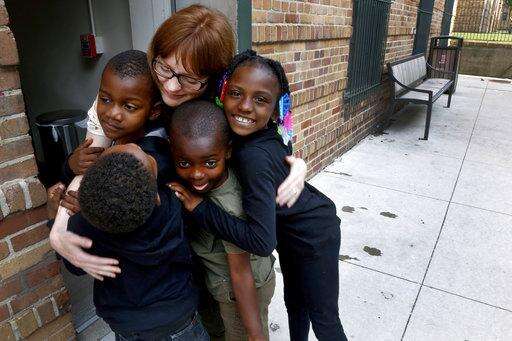
In this Monday, June 25, 2018, photo, Charlie Branda, founder of Art on Sedgwick, hugs a few young residents of Marshall Field Garden Apartments in Chicago. Branda, whom many children call "art teacher," is a former commercial banker who left the profession to raise her two children, now teens. Though she doesn't consider herself an artist, she later opened a neighborhood art studio called Art on Sedgwick to try to unite a neighborhood divided by income and race. Her neighbors are often surprised to learn that, while she lives on the wealthier side of the neighborhood, she was raised by a single mom with modest means. (AP Photo/Martha Irvine)
The Associated Press

In this Friday, June 1, 2018, photo, two boys help finish a chalk mural at Marshall Field Garden Apartments during the Art on Sedgwick annual art show in Chicago. The theme of the mural "We all live here" was conceived by artist Rich Alapack who has focused the public art project at schools and community centers. "It's really a simple message -- but things are so divided," Alapack says. He said the goal is to bring people together. "Sometimes art can do that better than conversation." (AP Photo/Martha Irvine)
The Associated Press